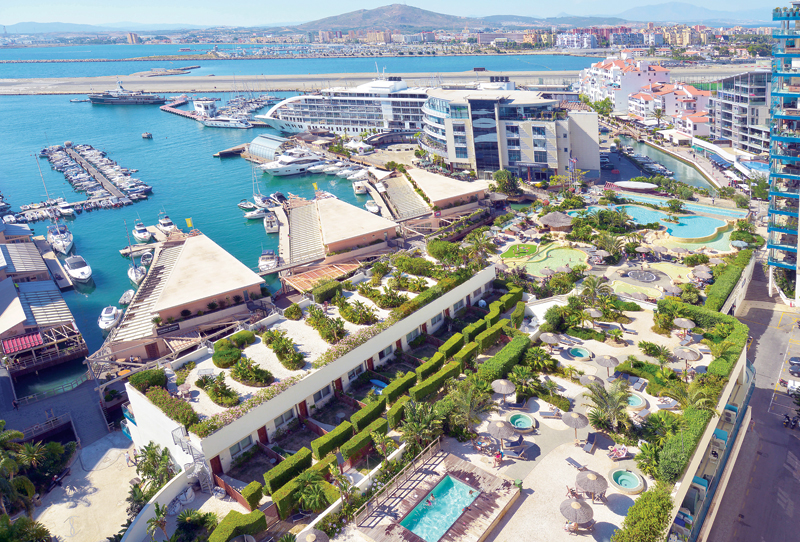

As the UK waited nervously for the outcome of the Brexit referendum in June 2016, the first result to arrive was from a territory that is in fact located far from British shores: Gibraltar. As you might expect, the island voted overwhelmingly to stay in the EU. But now, like the rest of Europe, it is having to brace itself for the changes ahead as Britain prepares for Brexit. Gibraltar is six and a half square kilometres in area and is located on the southern tip of Spain.

Britain captured the strategically important rocky outcrop between Europe and Africa in 1704, and Madrid has been demanding its return ever since.
The Brexit negotiations have given the quarrel fresh impetus and Gibraltar’s tourism industry is especially nervous — “the Rock” and its 32,000 inhabitants are very dependent on tourism and the free movement of goods and people to and from Spain.
Restaurants, hotels and supermarkets in the British overseas territory have to import everything from Spain, and most of their workers are Spanish.
“About 7,000 people commute across the border every day,” says Julian Byrne, chairman of the Gibraltar Federation of Small Businesses. “Will they still be allowed to work in Gibraltar after Brexit?”
Nicky Guerrero, Gibraltar’s director of tourism, argues that high regional unemployment means it is not in Madrid’s interest to impose border controls and worsen working conditions for Spaniards in Gibraltar.
But what about tourists? Several million holidaymakers visit the outcrop every year, and most come over the border from Spain.
Would they continue to arrive if border controls were tightened after Brexit?
“I’m sure they would,” says Guerrero. “Gibraltar has a lot to offer.” He’s not wrong.
Gibraltar is small and secure, making it particularly attractive to cruise ships, which often dock here for day trips.
Last year alone, 400,000 cruise ship passengers stopped off in Gibraltar, and the number looks set to climb.
The Rock is also popular with shoppers, since there is no VAT to pay — many visitors take the opportunity to stock up on tobacco, alcohol, perfume, watches, jewellery and electronic goods.
Gibraltar also boasts three Mediterranean beaches — Eastern Beach, Catalan Bay and Sandy Bay — and holidaymakers can go sailing, diving among submerged wrecks and dolphin watching.
One of the highlights of a trip to Gibraltar, though, is to be found at the Upper Rock Nature Reserve, where around 300 Barbary macaques can be found, the only monkeys to be found living in the wild in Europe.
The view from the reserve, which is also home to an 11th-century Moorish castle, is spectacular — stretching to three countries, two continents and two seas.
But let your guard down for a second and the monkeys will take advantage — extremely bold, they love stealing everything from glasses to wallets, bags and food. Gibraltar’s limestone terrain is also riddled with dozens of enormous caves, with the best known being St Michael’s Cave.
Gorham’s Cave Complex, which is thought to have been home to the last Neanderthals in Europe, was declared a UNESCO world heritage site last year.
Rock engravings and tools found there, which can be seen in the Gibraltar Museum, are many thousands of years old.
As well as the caves, visitors can also explore the “Great Siege Tunnels” built by British soldiers in the 18th century.
Another 50 kilometres of tunnels were added during World War II.
“The Rock is like a giant Swiss cheese,” says tour guide Tito Vallejo.
Gibraltar is saturated with history.
The Rock is one of the ancient Pillars of Hercules, which mark the entrance to the Strait of Gibraltar. The first known inhabitants after the Neanderthals were the Phoenicians, followed by the Romans.
In 711, it was conquered by Berber troops from North Africa, and aside from a brief period in the middle, it remained Muslim until 1462.
Gibraltar has a very different flavour from many holiday destinations, noticeable from the moment you arrive.
Vehicles are left backed up at the border for more than an hour as a flight from London arrives because the runway intersects Winston Churchill Avenue, the only road into Gibraltar from Spain.
On the streets, it’s difficult to know whether you’re in Spain or Britain.
On Casemates Square, you can eat fish and chips or paella, and drink beer or red wine. On the main street, British bobbies patrol under a fierce Spanish sun.
Coming out of Marks & Spencer, visitors are greeted by a hot wind from Morocco. Bacon and eggs are served just across the water from Africa.
“Gibraltar is historically, linguistically, architecturally and culturally a mixture of Britain, Spain, Portugal, Malta, Italy and Morocco,” says Vallejo. “We just took the best from each culture.”
Indeed, Gibraltar ought to be an example to the world, he says.
“Jews, Christians, Muslims and people from all over the world have always lived here peacefully side by side.”
Nevertheless, due to its strategic importance, its inhabitants have always lived under constant threat, a fact to which the cannon and defensive tunnel networks bear witness. They won’t be much help against Brexit, though. — dpa
Manuel Meyer
Oman Observer is now on the WhatsApp channel. Click here



